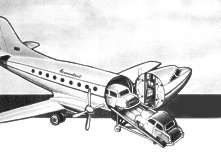 |
1954 publicity drawing showing
the proposed swing-nose version (The Aviation Buffs Archive - ATEL publicity as published in Flight) |
Aviation Traders ATL.90 Accountant
Short history |
During the 1950's several aircraft manufacturers started development of a DC-3 Dakota replacement. State of the art engines, turboprops, would power an aircraft with roughly the same capacity as the venerable Dakota, promising of course better performance. A huge market for this size of aircraft was thought to exist, but the failure of this concept has been proven by several aircraft designs including the virtually unknown ATL.90. Market studies during the period 1950-1952 had indicated a gap in the major aircraft manufacturers offerings, namely for a 30-34 seat transport aircraft. A new aircraft of this size would have to be more economical to operate than the DC-3 then still in widespread use. Similar ruggedness and ease of overhaul were of course of high importance. Aviation Traders (Engineering) Ltd., a Southend-based company specialised in (at that time) aircraft overhaul and modification, saw an opportunity to join the ranks of the aircraft manufacturers and started design of the ATL.90. During the 1953 SBAC fair, they released details of the new design which was to be powered by Rolls Royce Dart turboprops. To emphasize its operation economics, the name 'Accountant' was chosen. Of the 3 prototypes envisaged, only the first one was completed and it made its first flight with the temporary test registration G-41-1 on July 9, 1957. It was registered officially as G-ATEL afterwards. The ATL.90 design incorporated such design features as a pressurized fuselage (not fitted to the prototype), good single-engined handling and a wing offering both short take-off and landing capability and high speed efficiency. Many components were envisaged to be made according to the Heal method, i.e. the skin would be machined to incorporate the stringers. This method, as strong (or stronger) as the conventional skin-over-frame method, would cut manufacturing costs, it was thought. The method was tested on the prototype, but even before the first flight it was decided that production aircraft would feature standard construction methods. The strange fuselage shape was in part attributable to an envisaged swing-nose arrangement to allow bulky cargo to enter the fuselage. This arrangement, although not foreseen in the prototype, necessitated the far-aft nosewheel position, giving the aircraft a rather ugly appearance on the ground. Passenger appeal was not neglected though, and production aircraft would have featured a 'normal' fuselage shape. Accomodation for 28 passengers would be the standard, but a 42-seat stretched development (called the ATL.91) was already in the pipelines. A 14-seat executive version was also envisaged. Having flown the minimum required 15 hours, the ATL.90 was presented to the public at the 1957 SBAC fair at Farnborough. Hopes were high set, but orders were not forthcoming, although several airline companies, mainly American, and the Indian Air Force showed considerable interest. As early as January 1958, with the prototype having flown about 200 hours, the company decided to halt development since it was felt that the ATL.90 competitors (like the Handley Page Dart Herald and Fokker Friendship, both larger and well underway in their test programme) would be too hard to beat. Production would have been a problem for Aviation Traders as well, since they lacked both the skills and the space for this. Through the eyes of an accountant, the economically most viable decision was taken and Aviation Traders would never venture again in the design of a completely new aircraft. Thus, during 1958 the ATL.90 was cocooned at Southend and finally dismantled in 1960. |
| Technical data |
| Engines : 2 Rolls-Royce Dart R.Da Mk.512 of 1740 hp |
| Wing span : 25.15 m |
| Length : 18.93 m |
| Heighth : 7.70 m |
| Wing area : 58.71 m2 |
| Max.speed : 475 km/h at 7620 m |
| Cruis speed : 470 km/h at 4570 m |
| Range : 3360 km |
| Empty weight : 7700 kg |
| Max.take-off weight : 12930 kg |
| Accomodation : 12 - 40 passengers according to layout, typically 28 in a 4-abreast layout |
 |
1954 publicity drawing showing
the proposed swing-nose version (The Aviation Buffs Archive - ATEL publicity as published in Flight) |
If you entered this page directly and want to check out the rest of my website : click here to go to my Homepage. |
Last update : 24/05/01 - (c) Guido Van Roy